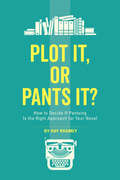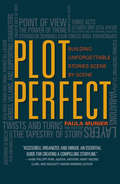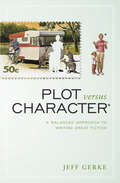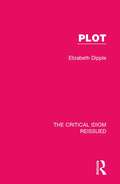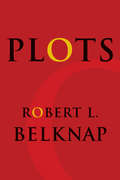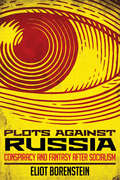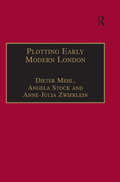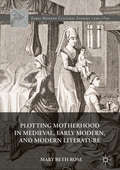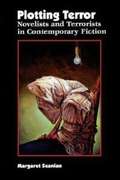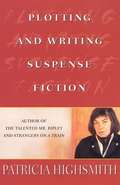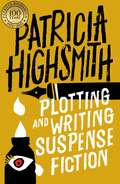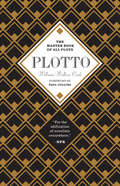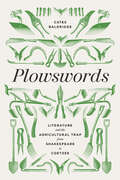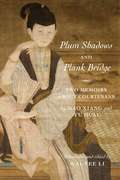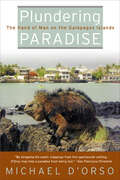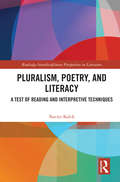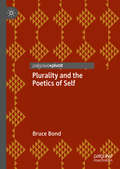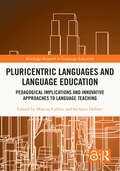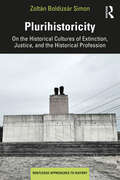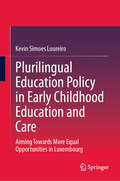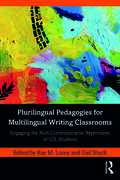- Table View
- List View
Plot It, or Pants It?: How to Decide If Pantsing Is the Right Approach for Your Novel
by Ray RhameyShould you "pants" your next novel? In the exclusive e-book "Plot It, or Pants It?" Ray Rhamey advises on the pros and cons of tossing the outline and writing by the seat of your pants. You'll get perspectives from several best-selling authors--from Elmore Leonard to Stephen King--on their approach to organic writing, and learn how to successfully pants a first draft while avoiding pitfalls. Ray Rhamey is an author, freelance fiction editor, and designer of book covers, interiors, and e-books for indie authors and small publishers. He writes the internationally known blog, Flogging the Quill, on creating compelling fiction. His how-to book, Mastering the Craft of Compelling Storytelling, has gotten rave reviews from writers. Ray's background includes screenwriting and advertising. Readers call him a "genre-bending" writer--his The Vampire Kitty-cat Chronicles is a satirical paranormal adventure, Gundown is a speculative thriller, The Summer Boy is a coming-of-age mystery set in 1958, and Hiding Magic is a blend of science fiction and contemporary fantasy. Learn more about Ray on his website: www.rayrhamey.com.
Plot Perfect: How to Build Unforgettable Stories Scene by Scene
by Paula MunierBuild an Exceptional Plot, One Scene at a Time! Think of your favorite story--the one that kept you turning pages late into the night, the one with a plot so compelling, so multilayered, so perfect that you couldn't put it down. How can you make your own plots--in your novels, short stories, memoirs, or screenplays--just as irresistible? Plot Perfect provides the answer. This one-of-a-kind plotting primer reveals the secrets of creating a story structure that works--no matter what your genre. It gives you the strategies you need to build a scene-by-scene blueprint that will help elevate your fiction and earn the attention of agents and editors. Inside, literary agent, editor, and author Paula Munier shows you how to: Devise powerful plots and subplots and weave them together seamlessly Organize your scenes for the greatest impact Develop captivating protagonists, worthy antagonists, and engaging secondary characters Use dialogue, setting, tone, and voice to enhance your plot Layer, refine, and polish your storyline Define your story in terms of its theme Filled with writing exercises, plotting templates, and expert advice, Plot Perfect helps you dive into the intricacies of plot--and write a compelling story that readers won't be able to resist.
Plot versus Character: A Balanced Approach to Writing Great Fiction
by Jeff GerkeWhat's more important to a story: a gripping plot or compelling characters? Literary-minded novelists argue in favor of character-based novels while commercial novelists argue in favor of plot-based stories, but the truth of the matter is this: The best fiction is rich in both. EnterPlot Versus Character. This hands-on guide to creating a well-rounded novel embraces both of these crucial story components. You'll learn to: Create layered characters by considering personality traits, natural attributes, and backgrounds Develop your character's emotional journey and tie it to your plot's inciting incident Construct a three-act story structure that can complement and sustain your character arc Expose character backstory in a manner that accentuates plot points Seamlessly intertwine plot and character to create a compelling page-turner filled with characters to whom readers can't help but relate And much more Filled with helpful examples and friendly instruction,Plot Versus Charactertakes the guesswork out of creating great fiction by giving you the tools you need to inject life into your characters and momentum into your plots.
Plot: Reading Contemporary Fiction (The Critical Idiom Reissued #11)
by Elizabeth DippleFirst published in 1970, this work examines ‘Plot’ as a literary term. It traces the two and contrary ways of considering the word: the Aristotelian and the neo-classic interpretations. It then goes on to examine the methods by which the idea of plot has been expanded in modern criticism through a proliferation of critical terms clustering around a vital idea of poiesis, and through the development of time theories, both literary and philosophical, which describe the action of creation. In doing so, the book leads the reader from the standard definition of plot as a hackneyed mechanical term to its enormous possibilities as both a definition and an action.
Plots (Leonard Hastings Schoff Lectures)
by Robert L. BelknapRobert L. Belknap's theory of plot illustrates the active and passive roles literature plays in creating its own dynamic reading experience. Literary narrative enchants us through its development of plot, but plot tells its own story about the making of narrative, revealing through its structures, preoccupations, and strategies of representation critical details about how and when a work came into being.Through a rich reading of Shakespeare's King Lear and Dostoevsky's Crime and Punishment, Belknap explores the spatial, chronological, and causal aspects of plot, its brilliant manipulation of reader frustration and involvement, and its critical cohesion of characters. He considers Shakespeare's transformation of dramatic plot through parallelism, conflict, resolution, and recognition. He then follows with Dostoevsky's development of the rhetorical and moral devices of nineteenth-century Russian fiction, along with its epistolary and detective genres, to embed the reader in the murder Raskolnikov commits. Dostoevsky's reinvention of the psychological plot was profound, and Belknap effectively challenges the idea that the author abused causality to achieve his ideological conclusion. In a final chapter, Belknap argues that plots teach us novelistic rather than poetic justice. Operating according to their own logic, plots provide us with a compelling way to see and order our world.
Plots against Russia: Conspiracy and Fantasy after Socialism
by Eliot BorensteinIn this original and timely assessment of cultural expressions of paranoia in contemporary Russia, Eliot Borenstein samples popular fiction, movies, television shows, public political pronouncements, internet discussions, blogs, and religious tracts to build a sense of the deep historical and cultural roots of konspirologiia that run through Russian life. Plots against Russia reveals through dramatic and exciting storytelling that conspiracy and melodrama are entirely equal-opportunity in modern Russia, manifesting themselves among both pro-Putin elites and his political opposition. As Borenstein shows, this paranoid fantasy until recently characterized only the marginal and the irrelevant. Now, through its embodiment in pop culture, the expressions of a conspiratorial worldview are seen everywhere. Plots against Russia is an important contribution to the fields of Russian literary and cultural studies from one of its preeminent voices.
Plotted: A Literary Atlas
by Daniel Harmon Andrew DegraffThis incredibly wide-ranging collection of maps--all inspired by literary classics--offers readers a new way of looking at their favorite fictional worlds. <P><P>Andrew DeGraff's stunningly detailed artwork takes readers deep into the landscapes from The Odyssey, Hamlet, Pride and Prejudice, Invisible Man, Lord of the Flies, A Wrinkle in Time, Watership Down, The Handmaid's Tale, and more. Sure to reignite a love for old favorites and spark fresh interest in more recent works as well, Plotted provides a unique new way of appreciating the lands of the human imagination.
Plotting Early Modern London: New Essays on Jacobean City Comedy (Studies in Performance and Early Modern Drama)
by Dieter MehlWith the publication of Brian Gibbons's Jacobean City Comedy thirty-five years ago, the urban satires by Ben Jonson, John Marston and Thomas Middleton attained their 'official status as a Renaissance subgenre' that was distinct, by its farcical humour and ironic tone, from 'citizen comedy' or 'London drama' more generally. This retrospective genre-building has proved immensely fruitful in the study of early modern English drama; and although city comedies may not yet rival Shakespeare's plays in the amount of editorial work and critical acclaim they receive, both the theatrical contexts and the dramatic complexity of the genre itself, and its interrelations with Shakespearean drama justly command an increasing level of attention. Looking at a broad range of plays written between the 1590s and the 1630s - master-pieces of the genre like Eastward Ho, A Trick to Catch the Old One, The Dutch Courtesan and The Devil is an Ass, blends of romance and satire like The Shoemaker's Holiday and The Knight of the Burning Pestle, and bourgeois oddities in the Shakespearean manner like The London Prodigal - the twelve essays in this volume re-examine city comedy in the light of recently foregrounded historical contexts such as early modern capitalism, urban culture, the Protestant Reformation, and playhouse politics. Further, they explore the interrelations between city comedy and Shakespearean comedy both from the perspective of author rivalry and in terms of modern adaptations: the twenty-first-century concept of 'popular Shakespeare' (above all in the movie sector) seems to realign the comparatively time- and placeless Shakespearean drama with the gritty, noisy and bustling urban scene that has been city comedy's traditional preserve.
Plotting Motherhood in Medieval, Early Modern, and Modern Literature (Early Modern Cultural Studies 1500–1700)
by Mary Beth RoseThis book explores the inconsistent literary representations of motherhood in diverse texts ranging from the fourth to the twentieth centuries. Mary Beth Rose unearths plots startling in their frequency and redundancy that struggle to accommodate —or to obliterate—the complex assertions of maternal authority as it challenges traditional family and social structures. The analysis engages two mother plots: the dead mother plot, in which the mother is dying or dead; and the living mother plot, in which the mother is alive and through her very presence in the text, puts often unbearable pressure on the mechanics of the plot. These plots reappear and are transformed by authors as diverse in chronology and use of literary form as Augustine, Shakespeare, Milton, Oscar Wilde, and Tony Kushner. The book argues that, insofar as women become the second sex, it is not because they are females per se but because they are mothers; at the same time the analysis probes the transformative political and social potential of motherhood as it appears in contemporary texts like Angels in America.
Plotting Terror: Novelists and Terrorists in Contemporary Fiction
by Margaret ScanlanIs literature dangerous? In the romantic view, writers were rebels--Shelley's "unacknowledged legislators of mankind"--poised to change the world. In relation to twentieth-century literature, however, such a view becomes suspect. By looking at a range of novels about terrorism, Plotting Terror raises the possibility that the writer's relationship to actual politics may be considerably reduced in the age of television and the Internet.Margaret Scanlan traces the figure of the writer as rival or double of the terrorist from its origins in the romantic conviction of the writer's originality and power through a century of political, social, and technological developments that undermine that belief. She argues that serious writers like Friedrich Dürrenmatt, Doris Lessing, and Don DeLillo imagine a contemporary writer's encounter with terrorists as a test of the old alliance between writer and revolutionary.After considering the possibility that televised terrorism is replacing the novel, or that writing, as contemporary theory would have it, is itself a form of violence, Scanlan asks whether the revolutionary impulse itself is dying--in politics as much as in literature. Her analyses take the reader on a fascinating exploration of the relationship between actual bombs and stories about bombings, from the modern world to its electronic representation, and from the exercise of political power to the fiction writer's power in the world.
Plotting and Writing Suspense Fiction
by Patricia HighsmithIn this book, Patricia Highsmith analyzes the key elements of suspense fiction, drawing upon her own experience in four decades as a working writer. She talks about, among other topics; how to develop a complete story from an idea; what makes a plot gripping; the use (and abuse) of coincidence; characterization and the "likeable criminal"; going from first draft to final draft; and writing the suspense short story.
Plotting and Writing Suspense Fiction
by Patricia HighsmithNamed by The Times as the all-time number one crime writer, Patricia Highsmith was an author who broke new ground and defied genre clichés with novels such as The Talented Mr Ripley and Strangers on a Train.In the classic creative writing guide Plotting and Writing Suspense Fiction, Highsmith reveals her secrets for producing world-class crime and thrillers, from imaginative tips for generating ideas to useful ways of turning them into stunning stories.
Plotto
by William Wallace CookA classic how-to manual, William Wallace Cook's Plotto is one writer's personal method, painstakingly diagrammed for the benefit of others. The theory itself may be simple - "Purpose opposed by Obstacle yields Conflict" - but Cook takes his "Plottoist" through hundreds of situations and scenarios, guiding the reader's hand as a dizzying array of purposes and obstacles come to a head. Cook's method is broken down into three stages: First, the master plot. This four-page chart distills the most basic plot points into a three-line sentence. Next, the conflict situation. Each master plot leads the reader to a list of circumstances, distributed among 20 different conflict groups (these range from "Love's Beginning" to "Personal Limitations" to "Transgression"). There are over 2,000 unique conflict situations in the book, and each is cross-referenced with designs for how the situation might have started, or where it might go. Finally, there are character combinations - Cook offers an extensive index of protagonists, each cross-referenced with various supporting players - themselves tied to various conflict situations, for what appears to be an inexhaustible reservoir of suggestions and inspiration.
Plotto: The Master Book of All Plots
by William CookA classic how-to manual, William Wallace Cook's Plotto is one writer's personal theory--"Purpose, opposed by Obstacle, yields Conflict"--painstakingly diagrammed through hundreds of situations and scenarios A classic how-to manual, William Wallace Cook's Plotto is one writer's personal method, painstakingly diagrammed for the benefit of others. The theory itself may be simple--"Purpose, opposed by Obstacle, yields Conflict"--but Cook takes his "Plottoist" through hundreds of situations and scenarios, guiding the reader's hand through a dizzying array of "purposes" and "obstacles." The method is broken down into three stages: 1. The Master Plot 2. The Conflict Situation 3. Character Combinations In the first stage, Cook demonstrates that "a character with particular traits . . . finds himself in a situation . . . and this is how it turns out." Following this, each Master Plot leads the reader to a list of circumstances, distributed among twenty different Conflict Groups (these range from "Love's Beginning," to "Personal Limitations," to "Transgression"). Finally, in Character Combinations, Cook offers an extensive index of protagonists for what serves as an inexhaustible reservoir of suggestions and inspiration.
Plotto: The Master Book of All Plots
by William CookA classic how-to manual, William Wallace Cook's Plotto is one writer's personal theory--"Purpose, opposed by Obstacle, yields Conflict"--painstakingly diagrammed through hundreds of situations and scenarios A classic how-to manual, William Wallace Cook's Plotto is one writer's personal method, painstakingly diagrammed for the benefit of others. The theory itself may be simple--"Purpose, opposed by Obstacle, yields Conflict"--but Cook takes his "Plottoist" through hundreds of situations and scenarios, guiding the reader's hand through a dizzying array of "purposes" and "obstacles." The method is broken down into three stages: 1. The Master Plot 2. The Conflict Situation 3. Character Combinations In the first stage, Cook demonstrates that "a character with particular traits . . . finds himself in a situation . . . and this is how it turns out." Following this, each Master Plot leads the reader to a list of circumstances, distributed among twenty different Conflict Groups (these range from "Love's Beginning," to "Personal Limitations," to "Transgression"). Finally, in Character Combinations, Cook offers an extensive index of protagonists for what serves as an inexhaustible reservoir of suggestions and inspiration.
Plotto: The Master Book of All Plots
by William CookA classic how-to manual, William Wallace Cook's Plotto is one writer's personal theory--"Purpose, opposed by Obstacle, yields Conflict"--painstakingly diagrammed through hundreds of situations and scenarios A classic how-to manual, William Wallace Cook's Plotto is one writer's personal method, painstakingly diagrammed for the benefit of others. The theory itself may be simple--"Purpose, opposed by Obstacle, yields Conflict"--but Cook takes his "Plottoist" through hundreds of situations and scenarios, guiding the reader's hand through a dizzying array of "purposes" and "obstacles." The method is broken down into three stages: 1. The Master Plot 2. The Conflict Situation 3. Character Combinations In the first stage, Cook demonstrates that "a character with particular traits . . . finds himself in a situation . . . and this is how it turns out." Following this, each Master Plot leads the reader to a list of circumstances, distributed among twenty different Conflict Groups (these range from "Love's Beginning," to "Personal Limitations," to "Transgression"). Finally, in Character Combinations, Cook offers an extensive index of protagonists for what serves as an inexhaustible reservoir of suggestions and inspiration.
Plowswords: Literature and the Agricultural Trap from Shakespeare to Coetzee
by Cates BaldridgeA critical examination of the &‘agricultural trap&’ in literature For thousands of years, agriculture and civilization were essentially synonymous. The superiority of farming over the unsettled, itinerant life of hunting and gathering appeared, to many, self-evident. Only recently has the field of anthropology challenged this assumption by positing that foragers were, and are, actually happier and healthier than people living in agro-cultures. Plowswords is the first work to consider the refiguring of the agricultural revolution into the agricultural trap through a literary lens. Reading texts that depict farmers in conflict with foragers, Cates Baldridge argues that agricultural ideology justified the tedium and toil of farming by enlisting a rhetorical foil: the &“savage&” and &“backward&” hunter-gatherer. Texts such as The Tempest, Robinson Crusoe, Frankenstein, Wuthering Heights, Heart of Darkness, and the novels of J. M. Coetzee use this figure either to exalt farming&’s triumph over foraging or to mourn the consequences of the agricultural turn, anxiously championing or stridently challenging the received wisdom of humanity&’s supposed progress.
Plum Shadows and Plank Bridge: Two Memoirs About Courtesans (Translations from the Asian Classics)
by Xiang Mao Huai YuAmid the turmoil of the Ming-Qing dynastic transition in seventeenth-century China, some intellectuals sought refuge in romantic memories from what they perceived as cataclysmic events. This volume presents two memoirs by famous men of letters, Reminiscences of the Plum Shadows Convent by Mao Xiang (1611–93) and Miscellaneous Records of Plank Bridge by Yu Huai (1616–96), that recall times spent with courtesans. They evoke the courtesan world in the final decades of the Ming dynasty and the aftermath of its collapse.Mao Xiang chronicles his relationship with the courtesan Dong Bai, who became his concubine two years before the Ming dynasty fell. His mournful remembrance of their life together, written shortly after her early death, includes harrowing descriptions of their wartime sufferings as well as idyllic depictions of romantic bliss. Yu Huai offers a group portrait of Nanjing courtesans, mixing personal memories with reported anecdotes. Writing fifty years after the fall of the Ming, he expresses a deep nostalgia for courtesan culture that bears the toll of individual loss and national calamity. Together, they shed light on the sensibilities of late Ming intellectuals: their recollections of refined pleasures and ruminations on the vagaries of memory coexist with political engagement and a belief in bearing witness. With an introduction and extensive annotations, Plum Shadows and Plank Bridge is a valuable source for the literature of remembrance, the representation of women, and the social role of intellectuals during a tumultuous period in Chinese history.
Plundering Paradise: The Hand of Man on the Galápagos Islands
by Michael D'OrsoMention the Galápagos Islands to almost anyone, and the first things that spring to mind are iguanas, tortoises, volcanic beaches, and, of course, Charles Darwin. But there are people living there, too -- nearly 20,000 of them. A wild stew of nomads and grifters, dreamers and hermits, wealthy tour operators and desperately poor South American refugees, these inhabitants have brought crime, crowding, poaching, and pollution to the once-idyllic islands. In Plundering Paradise, Michael D'Orso explores the conflicts on land and at sea that now threaten to destroy this fabled "Eden of Evolution."
Pluralism, Poetry, and Literacy: A Test of Reading and Interpretive Techniques (Routledge Interdisciplinary Perspectives on Literature)
by Xavier KalckDrawing from Medieval and Renaissance studies, analytic philosophy and pragmatism, Jewish studies, as well as ecocriticism and environmental humanities, this book demonstrates the consistent relationship between pluralism and literacy through the prism of poetry by confronting the history of interpretive practices with examples from American poets Robert Lax, Larry Eigner, Louis Zukofsky, Gary Snyder and Theodore Enslin. Divided into four areas of investigation—the meditative, the analytic, the diasporic and the ecological reader—it is an invitation to turn to premodern reading practices related to spiritual exercises as well as modern reading practices devoted to the critical pursuit of analytical knowledge. This study further reflects on the textual models of Jewish diaspora as another form of dialog between sacred and secular interpretive practices, before examining a final variation on this distinction by looking at the separation between contemplative and investigative perspectives on reading and writing nature.
Plurality and the Poetics of Self
by Bruce BondPlurality and the Poetics of Self investigates the words “I” and “self” as suggestive of eight territories of meaning. Via poetry’s lens into language and its limits, Bruce Bond explores the notion of self as identity, volitional agent, ego, existential monad, subjectivity, ontological origin, soul, and transpersonal psyche. Taking poetic meaning as our common currency, the book emphasizes the critical role of the un-representable and how embattled and confused assumptions threaten ever deeper alienation from one another and ourselves.
Pluricentric Languages and Language Education: Pedagogical Implications and Innovative Approaches to Language Teaching (Routledge Research in Language Education)
by Marcus Callies Stefanie HehnerThis book maps out the pedagogical implications of the global spread and diversification of pluricentric languages for language education and showcases new approaches that can take account of linguistic diversity. Moving the discussion of contemporary norms, aims, and approaches to pluricentric languages in language education beyond English, this book provides a multilingual, comparative perspective through case study examples of Spanish, French, German, Portuguese, Dutch, and Vietnamese. The chapters document, compare, and evaluate existing practices in the teaching of pluricentric languages, and highlights different pedagogical approaches that embrace their variability and diversity. Presenting approaches to overcome barriers to innovation in language education, the book will be of great interest to academics, researchers, doctoral students in the field of language education, as well as socio- and applied linguists. Practitioners interested in linguistic diversity more broadly will also find this book engaging.
Plurihistoricity: On the Historical Cultures of Extinction, Justice, and the Historical Profession (Routledge Approaches to History)
by Zoltán Boldizsár SimonThis book situates historical scholarship within a plurihistoricity of contemporary historical culture, exploring conflicting conceptions of historical change in technological utopias of human enhancement, in prospects of human extinction, in societal responses to the Anthropocene, and in the imperative of bringing colonial patterns of historical injustice to justice.Contemporary societies increasingly reclaim history from the academic pursuit of historiography. On the one hand, societal engagement in history is growing palpably. History is literally everywhere: in the fallen statues of past political regimes, in trajectories of environmental degradation, and in technological prospects of space expansion. On the other hand, societal demand for history seems to diminish rather than strengthen the authority of professionalized historical studies. What do these societal historicities stand for? How do they create pasts that matter? What futures do they desire or attempt to avoid? How do they view the historical transitions into those futures? And what is the societal role of historical scholarship and scholarly conceptions of history in the plurihistoricity of contemporary historical culture?By addressing these questions, Simon’s book is essential reading for everyone interested in the present and future of viewing the world historically.
Plurilingual Education Policy in Early Childhood Education and Care: Aiming Towards More Equal Opportunities in Luxembourg
by Kevin Simoes LoureiroThis book explores the implementation of educational policies aimed at addressing educational inequalities and specifically focuses on Luxembourg’s pioneering plurilingual education policy in non-formal early childhood education and care. It emphasizes the significance of developing plurilingual policies that accommodate diverse linguistic and organizational contexts, ensuring more effective implementation and equitable educational opportunities for all children. Through an in-depth analysis, this book provides insights into various aspects of policy implementation. It delves into the drivers and goals of the plurilingual policy, the measures taken to implement it, the challenges encountered, and the success factors identified at the policy level. Additionally, it examines the attitudes, intentions and obstacles faced by those involved at the practice level. Drawing on a range of theoretical frameworks and empirical studies, the book presents multiple perspectives on the subject. By employing a mixed-methods design, including policy document analysis of the plurilingual education program, expert interviews with policy-level stakeholders and a cross-sectional survey of early childhood practitioners in the non-formal education sector, this work offers a multifaceted approach. The book not only enhances the understanding of policy implementation processes, but also sheds light on the practical implications and potential for reducing educational inequalities in multilingual educational settings. The findings and discussions in this book are, thus, pertinent not only to Luxembourg, but also offer policy- and practice-related implications for similar educational contexts globally.
Plurilingual Pedagogies for Multilingual Writing Classrooms: Engaging the Rich Communicative Repertoires of U.S. Students
by Kay M. Losey Gail ShuckA much-needed resource on plurilingual pedagogies, this book counters the common dominant English-only approach found in writing and composition classrooms by identifying practices and pedagogies that support multilingual students. Providing a window into a range of contexts and classrooms where students’ full identities are honored, contributors offer research-grounded strategies and pedagogies that allow students to harness all of their language resources in order to build on their strengths and develop their writing abilities. The specific examples in this book, drawn from high school and college writing contexts, demonstrate the value of embracing linguistic diversity in writing programs. Presenting a wide range of models and strategies from top scholars that center students’ linguistic repertoires as strengths, the volume addresses classroom teaching, assessment, curriculum, school administration, and more, all from an asset-based orientation. This book is ideal for courses in composition and second-language writing pedagogy as well as for students, scholars, and educators in second language writing, language and literacy education, and composition studies.
